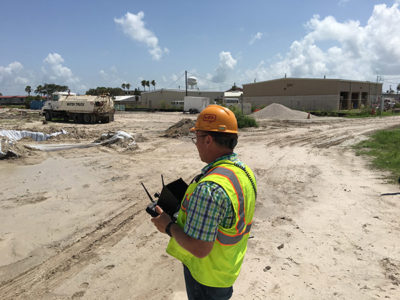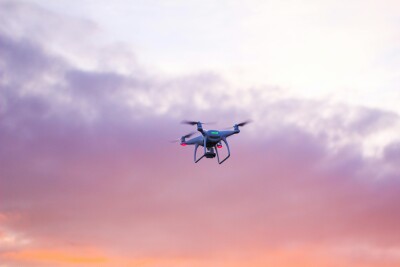Construction professionals have been working through what it could mean to utilize drone technology in order to create efficiencies for a long time now, but regulation was always cited as a barrier to entry. Many construction stakeholders determined that the potential value of creating a drone program did not outweigh the actual costs and headaches associated with adoption under Section 333.
That didn’t stop Richard Lopez, Virtual Design and Construction Manager at Hensel Phelps, from implementing a UAS program. He actually started a completely separate company to avoid the bigger liability issues that could have arisen otherwise. Under Part 107 though, all of that changed for him and for the industry as a whole since it meant that creating and scaling a drone program is now much more feasible.
For Hensel Phelps, the fact that their drone program wasn’t starting from scratch under Part 107 has been critical for the company. Lopez’s approach enabled him to create a process that is now being utilized across the entire organization. Their 8 districts have numerous personnel and personalities, but as one person sorting through what could and would make sense with the technology, Lopez was able to put a priority on safety and regulation. It’s an approach that defines what it means to successfully adopt the technology, regardless of when the adoption process begins.
 Creating a Construction Enterprise Drone Program
Creating a Construction Enterprise Drone Program
Under Part 107, the creation of an enterprise drone program is a completely different consideration for company stakeholders. It’s one of the main reasons the question of “build or outsource” when it comes to drones is so pervasive, especially in the construction industry. However, Part 107 hasn’t just changed the considerations around implementation. It’s also changed the expectations of everyone from contractors all the way up to owners.
“Part 107 has certainly opened up a lot of doors as we see a lot more people wanting to capture and use aerial data for a variety of purposes,” Lopez said. “Not only are we flying our job sites, but we're getting a lot of requests from sub-contractors to fly the sites. That’s given them a real situational awareness of the job site, even if it’s something simple like keeping better track of stockpiles. They know we're flying and we're keeping track of it, and they want that awareness as well, which is actually a good thing. It creates a kind of checks and balances setup.”
This change in expectation extends all the way up to the ownership level, as it’s not uncommon to have site owners who want to be able to fly a site using their own representatives to provide them with a situational awareness they’ve never been able to have. Overall that’s been a positive thing, but it’s also created another level of responsibility for Lopez and his team because if anything goes wrong on the site, his team is still responsible because they’re the general contractor. It’ why they need to make sure the right policies are in place to understand how to fly drones on a job site. Part 107 makes the regulatory considerations for such operators easier to sort through, but understanding what it means to fly a job site is about so much more.
When he first started the program, Lopez was under the impression that the bigger the airframe and the bigger the sensors, the better. But as he started to fly more projects he came to understand that “bigger” might just mean more issues, and that identifying what you’re trying to achieve by flying a drone is more critical than any details related to hardware or software.
“There are a variety of drones out there, and the key thing is identifying what your needs are,” Lopez told Commercial UAV News. “For example, if we have a project where we need to keep track of topos and earth movement, we have a unit for that. It's just about identifying the unit for a job, and that’s one of the reasons we've stuck with the DJI products that we like. There are tons of different products out there, but for us, that's what's working. Ultimately, drones are tools. The better we can utilize the tool and the better sensors we can get on them, the better off we'll be.”
Thinking of drones as just another tool in the toolkit is how many professionals are working to position the technology, and doing so has helped when it comes to enabling enterprise adoption. Regardless of positioning though, questions around ROI always come up and aren’t always easy to address. After all, how can you calculate the return on overage costs that never occur? What numbers are going to tell you that you’ve created efficiencies?
Being able to reconsider what kind of value the technology represents that goes beyond these measurables is one of the reasons Lopez has had and continues to enable success with his drone program.

Safety as the Real Value of Drone Technology
Talk about the potential drones have to make any given task faster, cheaper or safer is pervasive, and there are countless instances where it’s simple enough to measure the difference in time or costs. These numbers often take priority over the impact the technology has on safety, but that’s not the case at Hensel Phelps. In fact, if they were just focused on time and cost measurables, it’s likely their drone program would look much different.
“To tell you the truth, it's actually more expensive for us to fly a drone on a site versus us hiring someone out due to our employee rates,” Lopez admitted. “The thing is, we're not looking at it for the monetary value. We're looking at it more for the safety aspect. Us having control of the job site and knowing that our people aren’t being put in harm’s way and can react to developments much quicker is where the ROI is for us. If we can provide information to the superintendent, and they can then plan their workload and get all their crews in the right locations when they need to be there by looking at the aerial data, right there you have value.”
Lopez mentioned he had just returned from a job where this exact scenario played out. He watched a superintendent plan their morning meetings based on the drone information they received the day before. The drone flew the job site, processed the data, and then provided an ortho photo for the safety briefing. It gave that superintendent a completely different perspective that went beyond the info they were able to gather from walking the job site.
Of course, providing insight that enables more productive walks on a job site is a benefit that comes back to safety. For Lopez, ROI needs to be considered first and foremost from this safety aspect, but that value is also tied to providing data to the people who need it out in the field. This focus on safety is also tied to considerations around what solutions are chosen.
“We identified that the DJI Phantom was the line we wanted to use as our main drone, and part of the reason we did is because we determined that we wanted something that had obstacle avoidance sensors on it,” Lopez explained. “It’s a good thing we did because we just had an instance where the drone has gotten too close to a building, but the drone did exactly what it was supposed to do. It came up to the building and it stopped. The sensors picked up that building and it just stopped and held in place. If we had given crews the ability to fly whatever drone they wanted, that could have been a potential hit of a building and there would have been an incident for our drone program.”
The standards Lopez put in place meant drones that didn’t have these kinds of obstacle avoidance sensors on them wouldn’t be allowed on the job site. By having a strict and stringent protocol in place, Lopez has been able to ensure drones are an asset, rather than a liability. All of it comes back to his focus on reconsidering the true value of drones from the perspective of safety before anything and everything else.
These lessons are ones that haven’t come easy, and they’re issues that Lopez continues to work through. It’s part of the reason he’s been so open to discussing and showcasing what he’s learned at a variety of industry events.

Showing off a 0-60 Drone Program Roadmap at AirWorks
After figuring out what it meant for drone technology to make sense under Section 333, Lopez has been able to take the drone program at Hensel Phelps to the next level under Part 107. However, that doesn’t mean there aren’t still challenges for him. It’s part of the reason the insights he shares at events like DJI AirWorks are so valuable though. Their drone program is ever evolving, and the perspective he shares is based on real-world experiences, which provides a real sense of how to move forward with drone adoption.
“If someone is looking to start something with drones or further developing a program, you have to do your homework,” Lopez said. “You have to have something in place before you approach senior leadership. You might not have all the answers, but you at least have to have some of the policies and procedures in place. That goes a long way toward building confidence with senior leadership, and from there you just keep documenting everything. That's what we did.”
The drone program that Lopez created and still leads was prototyped in their district for a year. Once that year was up they rolled it out to all of their other districts, but enabling senior leadership to understand what each phase was going to look like was critical. Lopez laid out how each district needed to identify their champions early on, and made sure they understood the rules of engagement when it came to following all the protocols. Senior leadership didn’t want each district doing their own thing, and that was something Lopez directly addressed in his planning and implementation.
Those experiences are just part of what Lopez is planning to showcase during his presentation at AirWorks this year. It’s not just about the big picture though, as Lopez will also be detailing what it has meant for his team to create the zone maps they use every time they fly a mission. They're a way of communicating to visual observers on a job site, and they help everyone know where that drone is at any given time. This focus on the big picture while also exploring critical details will define his presentation.
“It's going to be a roadmap of what it means to go from 0-60 with drone technology,” Lopez said. “It'll get into how we started off, the documents that we have in place and the procedures we have in place. I want to give people a sense of how they can move forward with the technology, but I know a lot of these specifics aren’t going to make sense for everyone. Our focus on safety is what makes the technology work for us though, and I think that’s a concept which is going to be relevant in many other industries and applications.”
Creating a drone program will look a bit different depending on the company and industry, but the program that Lopez created took bits and pieces from other programs, all while focusing on safety above all else. It’s an approach that has worked especially well for Hensel Phelps, all of which have come from the roadmap Lopez has created.
















Comments